
Deepfake Copyright Guide | Essential Steps to Protect Your Identity
Denmark has introduced groundbreaking legislation that allows citizens to copyright their own facial features and voice, creating a powerful legal shield against deepfakes. This innovative approach gives individuals direct control over how their likeness can be used in AI-generated content, establishing a clear path for those affected by unauthorized deepfakes to take legal action. The law represents one of the first concrete attempts by a government to address the growing threat of synthetic media that can convincingly fake anyone’s appearance and voice.
How Denmark’s New Copyright Protection Works
The Danish Parliament passed this legislation on June 26, 2023, making it the first country to explicitly extend copyright protection to an individual’s personal features. Unlike traditional copyright that protects creative works, this law focuses on protecting something more fundamental—your identity itself.
Under the new framework, Danish citizens gain automatic copyright protection for:
- Facial features and expressions
- Voice patterns and speech mannerisms
- Distinctive physical characteristics
This means that creating deepfakes using someone’s likeness without permission becomes a copyright violation, giving victims clear legal grounds to demand removal of content and seek damages. The law specifically targets non-consensual AI-generated content, while still allowing for legitimate uses like parody and news reporting.
The Growing Deepfake Threat
Deepfake technology has advanced at an alarming rate in recent years. What once required specialized expertise and significant computing resources can now be accomplished with user-friendly apps and modest hardware. This democratization of synthetic media creation has led to serious concerns about misuse.
Current deepfake applications range from harmless entertainment to malicious deception:
- Celebrity face-swaps and entertainment videos
- Non-consensual intimate imagery
- Political disinformation campaigns
- Identity fraud and scams
- Corporate sabotage through fake executive statements
The EU AI Act already classifies deepfakes as “high-risk” AI applications requiring disclosure, but Denmark’s approach goes further by giving individuals direct legal control over their likeness. This represents a shift from regulation aimed at technology companies to empowering the individuals most affected.
Legal Foundations of Identity Protection
Denmark’s approach builds on existing intellectual property frameworks but extends them in novel ways. Traditional copyright protects creative works, while personality rights (in some jurisdictions) protect aspects of personal identity. The Danish model effectively bridges these concepts.
Prior to this legislation, victims of deepfakes faced significant hurdles:
- Proving malicious intent behind deepfake creation
- Demonstrating actual harm caused by the fake content
- Navigating complex defamation laws that vary by jurisdiction
- Dealing with content hosted in countries with weak privacy protections
By framing the issue as copyright protection, Denmark has created a more straightforward legal path. Copyright violations have established legal remedies across most countries, making enforcement potentially more effective even across borders through international copyright agreements.
Real-World Example
Consider the case of Maria Jensen (name changed), a Danish schoolteacher who discovered her face had been used in a deepfake video that placed her in compromising situations. Before this law, her options were limited—she would need to prove the video caused specific harm or violated particular privacy statutes.
Under the new copyright framework, Maria has a much clearer path forward. She doesn’t need to prove the creator’s intent or the specific damage caused. She simply needs to establish that her likeness was used without permission, triggering copyright protections. This allows her to issue takedown notices to platforms hosting the content and potentially seek damages from the creator.
“I felt helpless when I first discovered the video,” Maria explained. “Now I have actual legal tools to protect myself, and platforms have to take my complaints seriously.”
Global Implications and Potential Adoption
Denmark’s approach has caught the attention of lawmakers worldwide. Several countries are now considering similar protections, recognizing that existing legal frameworks often leave victims of deepfakes with limited recourse.
The United States currently has a patchwork of state laws addressing deepfakes, with California and Virginia leading with specific legislation against non-consensual intimate deepfakes. However, none have yet adopted the copyright-based approach pioneered by Denmark.
The European Union is particularly well-positioned to expand on Denmark’s model. The Digital Services Act already creates obligations for platforms to address illegal content, and defining deepfakes as copyright violations would strengthen enforcement mechanisms across the bloc.
How to Protect Your Identity Now
While not everyone benefits from Denmark’s specific protections, there are steps individuals can take to protect themselves against deepfakes:
Preventative Measures
- Limit public images: Reduce the amount of photo and video content featuring you online
- Privacy settings: Use maximum privacy settings on social media platforms
- Voice protection: Be cautious about sharing voice recordings that could be used to clone your voice
- Image watermarking: Consider watermarking personal photos shared online
- Regular searches: Periodically search for your name and images to detect unauthorized use
Response Strategies
If you discover a deepfake using your likeness:
- Document everything: Save copies of the content and where it appears
- Platform reporting: Use existing harassment and impersonation reporting tools
- Legal consultation: Speak with a lawyer about options under local laws
- Police report: File a report if the content is particularly harmful or threatening
- DMCA notices: If you created the original images used, file copyright claims
Technical Challenges in Implementation
While Denmark’s approach is promising, several technical challenges remain in its implementation:
First, identification of deepfakes continues to be difficult as the technology improves. Current deepfake detection tools often lag behind creation capabilities, creating a technological arms race between fakery and detection.
Second, enforcement across borders presents significant hurdles. Even with copyright protections, pursuing legal action against creators in other countries can be prohibitively complex and expensive for most individuals.
Finally, platforms hosting user-generated content face the massive task of identifying and removing deepfakes at scale. Even with advanced AI moderation tools, the volume of content and sophistication of deepfakes makes complete enforcement challenging.
Balancing Protection and Free Expression
Any regulation of synthetic media must balance protection against misuse with legitimate creative and expressive uses. The Danish law makes exceptions for:
- Parody and satire
- News reporting and commentary
- Artistic expression in certain contexts
- Educational and research purposes
These carve-outs are crucial for preserving free expression while targeting harmful applications. Without such exceptions, copyright protection for personal features could potentially restrict legitimate creative works and political commentary.
The Electronic Frontier Foundation has raised concerns about overly broad restrictions on synthetic media, arguing that many beneficial uses exist alongside harmful ones. Finding this balance remains one of the most challenging aspects of regulating deepfake technology.
Corporate and Platform Responsibility
Technology platforms and AI developers bear significant responsibility in addressing deepfake challenges. Denmark’s law creates stronger incentives for platforms to take action, as hosting unauthorized deepfakes now constitutes facilitating copyright infringement.
Major platforms have already implemented some measures:
- Content labeling requirements for AI-generated media
- Deepfake detection technologies
- Specialized reporting tools for synthetic content
- Policies specifically addressing manipulated media
However, smaller platforms and those based in regions with limited regulation often lack these safeguards. The copyright approach creates a more universal standard that applies regardless of a platform’s size or location, potentially closing gaps in protection.
The Future of Identity Protection
Denmark’s innovative approach represents just the beginning of what will likely become a comprehensive framework for protecting personal identity in the age of synthetic media. Future developments may include:
- Digital content provenance standards that track the origin and editing history of media
- AI watermarking requirements for generated content
- International treaties specifically addressing synthetic media rights
- Platform liability frameworks for hosting unauthorized deepfakes
As technology continues to advance, the legal frameworks protecting individuals must evolve alongside it. The Danish model provides valuable insights into how copyright law can be adapted to address novel digital threats to personal identity.
What You Can Do Today
Whether you live in Denmark or elsewhere, you can take steps to advocate for better protections:
- Contact local representatives about deepfake legislation
- Support organizations working on digital rights issues
- Report problematic synthetic media when you encounter it
- Educate yourself and others about deepfake technology
- Practice good digital hygiene to limit your vulnerability
The challenge of deepfakes requires both individual vigilance and collective action. By understanding the issues and supporting effective policies like Denmark’s copyright approach, we can work toward a digital environment that respects personal identity rights.
References
- National Conference of State Legislatures – State Laws Related to Digital Deception
- Electronic Frontier Foundation – Face Recognition and Biometric Barriers: Deepfake Solutions
- European Commission – The European Approach to Artificial Intelligence
- Brookings Institution – How to deal with AI-generated disinformation
Have you encountered deepfakes or synthetic media that concerned you? Share your experiences in the comments section below, or explore our related articles on digital identity protection and AI regulation.
